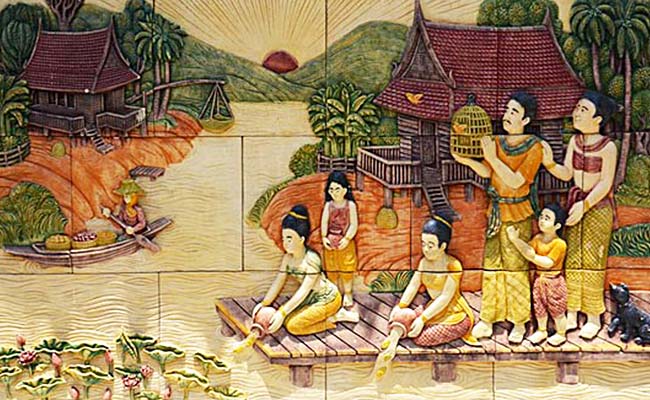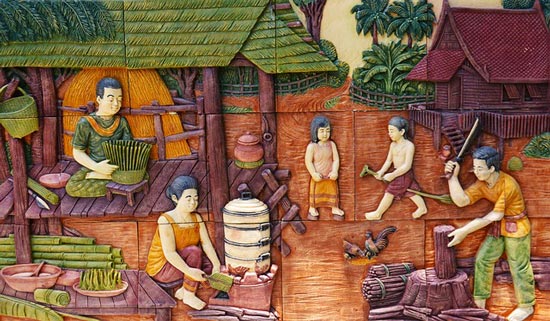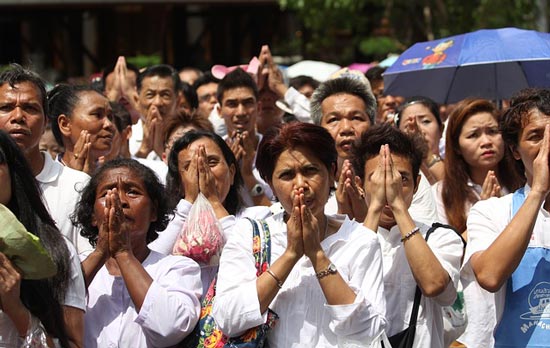Thailand has a fascinating history, particularly because over many centuries Thailand has adopted many cultural influences from surrounding regions.
This has happened through immigration and migration, and through war over territory.
But while the influential dynasties of kings and queens, the shifting geographical boundaries and religious influences — all of which have resulted in the unique Thainess we know today — are very interesting, one unanswered historical question remains the most fascinating aspect of Thailand:
From where do Thai people originate?
Now, a number of people reading this post may think they know the answer – people usually cite a version of the South China theory. But the fact is that the complexity of the origins of the Thai cannot be encompassed by a simple, straightforward explanation.
In fact, there are multiple theories (six, to be precise) on where the Thai originated.
I'd love to give you a definitive answer in this post, but that would be impossible.
However, what I can do is try to make sense of the dense historical and ethnological background of the people of Thailand, and give you all the information you need to come to your own conclusion on what seems most plausible, according to the evidence.

The Peopling of Thailand
As you probably anticipated, the people of Thailand are largely referred to as “Thais,” referring to both the country’s citizens and the ethnic majority, who are also related to the ethnic Lao people (in neighboring Laos).
The country is home to 75 percent Thai, 14 percent ethnic Chinese, four percent Malay Muslims, one percent Khmer (Cambodian), one percent Kui, one percent Karen, and .4 percent Indian and Pakistani.
There are roughly 20 million Lao-speaking-Lao-Isan people who live in northeast Thailand.
Thai-Isan people are often considered culturally distinct from those found in central Thailand, some considering them closer to the people of Lao.
This is an over generalisation, though, and has more to do with geographical proximity than descent.
There are many people originally from Central or Southern Thailand living in Northeast Thailand, who speak the regional dialect.
Indeed, there are parts of Northeast Thailand where other languages are spoken by minorities, such as Khmer by the Northern Khmer (Thai-Khmer).
While people may be considered of Lao or Cambodian descent, they are still part of the Tai group, which we'll get into in a moment.
There are also notable ethnic Thai-Chinese communities living throughout Thailand, including the Northeast, but particularly in the South.
However, we know that the majority of Thai-Chinese established themselves in Thailand over three waves of migration, dating back to the 13th Century:
Slightly more than half of the ethnic Chinese population in Thailand trace their ancestry to eastern Guangdong Province. This is evidenced by the prevalence of the Minnan Chaozhou dialect among the Chinese in Thailand. A minority trace their ancestry to Hakka and Hainanese immigrants. (Source: Wikipedia)
Our quest here is to uncover where the Thai (Tai) come from.
Moreover, if we look at Thailand as a whole, we see there are many cultural distinctions in different areas of the country.
For example, parts of the the South have a deep-rooted Malay influence, and in the North we see a mix of numerous tribes, many of whom have descended from neighbouring countries along the foothills of the Himalayas.
All these people are linked, or so it is thought, according to some theories.
So rather than trying to generalise where a particular group of people in a particular area of Thailand have descended from (originally), we are trying to identify a common heritage between those whose families have lived in Thailand, and indeed the immediate surrounding region, for many centuries.
And interestingly, as you'll note in the next section, the history explains how these different sub-groups are tied together.
The Tai
Genetically, Thai people descend from the Tai ethnolinguistic group (speakers of a common Tai language who are also found in other Southeast Asian countries and in China).
Thought to originate from Northern Mountains (Himalayas) – though we’ll discuss this in depth later- it’s assumed that the group migrated into modern-day Thailand and Laos, where its people settled and used their extensive agricultural intel to cultivate rice.
These first communities bordered river systems at the country’s tip, but over the years the ethnic group migrated to Thailand’s central plains, supplanting the existing Austroasiatic population.
As the Tai group spread, so did their language, becoming the mother-tongue of both Thailand and Laos.
As the group settled in different regions of the country and started communities, the ethnic subgroups of modern-day Thailand were created.
Today, 75 percent of Thailand’s population derives from the ethnic groups that descended from the Tai people, including the Central Thai (Siamese), the Southern Thai (Thai Pak Tai), the Khorat Thai, the Isan, the Yuan, the Assimilated Sino-Thai (Thai with Chinese heritage), and the Assimilated Khmer-Thai (of Cambodian origin).
Most of the groups populate central and southern Thailand, due to their original settlement near the Chao Phraya River, which winds its way through modern-day Bangkok.
The Lao-Isan call Northern/Northeastern Thailand home (as discussed earlier).
In general, the following subgroups populate different regions and speak distinct dialects:
The Shan live in Mae Hong Son, the Thai Lus in Chiang Rai, the Thai Khorat in Khorat, the Yaw in Nakhon Phanom, the Lao Song in Phetburi, the Lanna in Northern Thailand, the Isan people in northeastern Thailand, and the Thai Oak Tai in southern Thailand.

Origin Theories
The supposition above may provoke controversy, depending on what you believe about the origin of Thai people. And mind you, there are no less than six theories about the ethnic origin of the Kingdom’s peoples.
Theory 1: The Mongolian Origins Theory
The Mongolians origin theory was initiated by American missionary W.C. Dodd, who made Thailand his home for 32 years.
Dodd believed that the Tai ethnolinguistic group had descended from the Mung people of the Altai Mountains, who had left their lofty dwellings and migrated to China’s western front.
Though his idea was certainly unique, Dodd offered little proof that this theory was correct.
Later, a Thai politician named Kun Vichit-Matra snowballed off of Dodd’s predilection, confidently stating that the Tai people’s origin was indeed the Altai mountains, but suggesting that their migration had been rerouted through China’s Yellow River basin and down through the province of Szechuan.
Though both are interesting theories, modern-day scholars have debunked them, noting that neither the Mung nor the Tai could have survived a crossing of the unforgiving Gobi desert.
In addition, the Tai culture was known for its extensive knowledge of agriculture and cultivation. It seems unlikely that such a civilization would suddenly become nomadic.
Theory 2: The Central China Origins Theory
This theory got its start with linguist Terrien de La Couperie, a Frenchman who had been tasked with the study of ancient Chinese records.
After studying the complex linguistic patterns of both China and Thai, La Couperie concluded that the Tai people originated in central China, pointing to the uncanny similarities in language between the Mung people (who represented an ethnic minority in their home province of Szechuan) and the Tai people who later populated Southeast Asia.
Gleaning information from a document from China’s Xia Dynasty, La Couperie claimed that the Tai had originated from an ancient kingdom in China in 1223 B.C.
Critics have pointed out that the document La Couperie studied is a replication – not an original – and its information has not been verified, largely debunking his theory in academic circles.
Later, Thai Prince Damrong corroborated this theory but suggested that the Tai people settled in the area between China and Tibet in 44 B.C., but were forced into China’s Yunnan province by aggressors.
Once in Yunnan, the groups separated into separate tribes. Damrong believed that the Ngiew and Shan populated the west, the “Twelve Tai Tribes” moved to the southeastern tip, and the Lan Na and Lan Chang occupied the south.
In the 1940s, Thai theorist Phraya Anuman Raja-Thon suggested that the Tai people originated in central China, as well, but this time in the Yangtze basin, migrating from Szechuan to the east.
A contemporary, Phra Boriharn-Thep Tani, argued that the Tai people certainly originated in central China, but then moved to Yunnan and Indochina.
Though this theory has been explored extensively, anthropologists point to key physical, lifestyle and cultural differences between central Chinese populations and modern-day descendants of the Tai people.
This theory has been largely discredited in Southeast Asia.
Theory 3: The South China Origins Theory
In 1886, an English explorer named A.R. Colquhoun was certain he’d determined the origin of the Tai peoples, proposing the South China Origins Theory.
After exploring Southeast Asia from Burma to India, he proposed that a similar lifestyle and language between the regions made the connection between the two groups likely, if not certain.
Spurred by Colquhoun’s proposition, England’s vice-consul to Hainan, Parker, pointed to Chinese lore and mythology to suggest the Tai’s involvement in the Nan Xiao Kingdom in China’s Yunnan province.
Adapting this theory, a German anthropologist named Wolfram Eberhard concluded that the Tai originated in Kwangtung, but eventually migrated through Yunnan to Vietnam, founding the Tan Kingdom and then the Nan Xiao.
Other theories reflected the belief that the Tai ethnolinguistic group had originated in China’s southernmost region, though their migration paths had all differed.
This theory has been discussed at length, and while some sociologists and anthropologists still believe that the South China Origins Theory holds true, it is still hotly debated.

Theory 4: The Indochina-Thailand Origins Theory
The Indochina/Thailand Origins Theory was initially proposed by American linguist and anthropologist, Paul King Benedict.
He believed that the commonalities between the Tai language and the Kadai language (characteristic of southern China and having similarities to Indonesian dialects) suggest that Tai, Java-Malay, and Tibetan-Burmese groups were all linked under a cultural umbrella called ‘Austronesian.’
Judging by the fact that Tai, Kadia, and Indonesian speech patterns show surprising similarities, Benedict hypothesized that the Tai originated in Indochina and that it was likely that they were Thailand’s original native group.
Benedict then predicted that a group (Mon-Khmer) pushed the Tai into southern China nearly 4,000 years ago, but that they later migrated back into Burma, Northern Thailand, Laos, and Northern Vietnam between 800 and 1,000 years ago.
Though Benedict’s theory is both detailed and extensive, there’s debate about whether or not this theory is grounded in evidence and fact.
Theory 5: The Skulls Theory
Researcher H.G. Quaritch Wales attempted to prove that the Tai people had originated in Thailand itself by using skulls he found and studied in Kanchanaburi Province, which dated back to 50 A.D.
He compared them to modern-day Thai skulls and concluded that the two were extremely similar, theorizing that the Tai people had occupied Thailand for the past two millennia.
This idea was corroborated by Sud San-Vichien, a physiologist who compared ancient bones from Kanchanaburi and Rajaburi provinces with bones from modern-day ethnic Thais, concluding that they were virtually identical.
He, too, concluded that modern-day Thailand was the original home of the Tai ethnolinguistic group.
To corroborate, archaeologists and anthropologists have found evidence of continuity in culture, tradition, physiology, and civilization. Today the theory is debated, but it is one of the most popular regarding the origins of the Kingdom’s people.
Theory 6: The Malay-Indonesian Origins Theory
And if you weren’t confused already, the last theory, the Malay-Indonesian Origins Theory, supposes that the Tai group shares a close relation to the populations of Java.
A researcher named Somsak Punta-Sombun determined this after exploring the interwoven relationship of genetics and blood type.
He found that ethnic Thai and Chinese people have dissimilar genetics and that there was a much closer relationship between Thai and Javanese civilizations. He even presumed that the Tai group may have lived in Java.
Additionally, famed Thai anthropologist and physician, Pravej Vasi, found high blood levels of Hemoglobin E in populations living in Southeast Asia, and in the Tai, Khmer, and Mon civilizations, but he did not find any of the blood markers in Chinese populations.
These findings throw a wrench in China-centric theories, and lend credibility to the Malay-Indonesian theory.
But Wait! There's More…
There's something else to consider too:
Despite the varied circumstances of these multiple theories, research states that radiometrically dated artifacts found in the Kingdom’s Central Lampang province push paleoanthropologists to agree that hominids must have reached mainland Southeast Asia before they spread into China and Indonesia, meaning that theories supposing migrations from specific provinces in China might not be as accurate as we think.
The Thai origin story may have actually been the complete opposite, with hominids expanding into China and Indonesia from what we now know as Northern Thailand.
In addition, it’s possible that the Tai group expanded into China and Indonesia to establish themselves in cultures over many millennia — there may have also been multiple migrations over thousands of years, which culminated in the ethnic mix that we see today.
In addition, the finding in Lampang would predate the Ban Chiang Archaeological Site, which is presumed by many to be the oldest and most significant prehistoric settlement in Southeast Asia and a landmark that many use to explain important information about the life of the earliest Tai settlers.
While information about the origin of the Tai ethnolinguistic group is still developing, these six theories paint an interesting picture of migration patterns within China and Southeast Asia thousands of years ago.
Whether Thailand acted as the cradle of the Tai civilization or whether it became a significant migration site for groups originating in either Indochina, Java, or mainland China, it's a country defined by the rich diversity it mothers and the cultural legacy of its people.
Having studied all the theories, the only thing I can really conclude is that the origin of the Thai simply depends on how far you are able to go back through history; though I find it incredibly interesting that hominids may have first settled in what we now know as Thailand prior to migrating to China.
Is it possible that the majority of Thai, Laos, Khmer and Burmese people are linked to these early hominid settlers?
Is it possible that they migrated to China, settled there and spread out and created different communities, and then began migrating back into what we now know as Thailand, Lao, Cambodia, and Mayamar, and possibly Malaysia and Indonesia?
Fascinating.
—-
I have tried to be as accurate as possible in my representation of each one of these theories. If you spot an error or feel there is a misrepresentation, or you have anything else to add to the debate on where Thai people originate, I'd be grateful if you can leave in the comments section below. It would be fantastic to hear from any anthropologists or historians who know far more about this subject than I do.
Last Updated on



Mr.Sirapach says
Apr 03, 2024 at 2:13 am
TheThailandLife says
Apr 03, 2024 at 3:35 pm
Mr.Sirapach says
Apr 03, 2024 at 5:05 pm
Chandra Singh says
Another Tai kingdom was born, called Ayutthaya. Actually, Ayutthaya's first king was a Chinese merchant who married a Khmer princess in Lopburi or the Lavo Kingdom, a Khmer vassal state (formerly the Dvaravati kingdom, a Mon kingdom controlled by the Khmer). Ayutthaya was a mix of Khmer, Mon, and Tai people. When Ramathibodi was crowned king, he inherited all Khmer culture from his father-in-law's kingdom (Lavo). With the support of the Khmer, Mon, and Tai people in Lavo, he united all the small Tai kingdoms that were under the rule of the Khmer Empire against the Khmer.
Day by day, Ayutthaya became more powerful. Meanwhile, the central power of the Khmer Empire started to wane due to religious conflict. Ayutthaya invaded Yaśodharapura city (Angkor Thom) in 1352. When they won the battle, they took all Khmer people, including royal families, officers, scholars, Brahmins, and other Khmer treasures, to Ayutthaya. This is why Khmer and Thai culture are very similar:
- The Tai founded their kingdom on the Khmer Empire's land and adopted Khmer culture.
- Ayutthaya attacked Yaśodharapura city (Angkor Thom), won the battle, and took Khmer people to support their new kingdom. Over centuries, all the Khmer people taken from Angkor became the ancestors of some modern Thais. So, Thais did not copy from the Khmer; they inherited from their Khmer ancestors.
- King Naresuan of Siam conquered Longvek in 1593 and also took Khmer people, royal families, scholars, and Khmer treasures to the Siam Kingdom. Do you believe all the people taken from Longvek were killed?
- The Siam kingdom extended its power into the Khmer Empire's land. The Khmer people who lived in that area became Siamese, so their culture also remained and became the root of Thai culture.
Why do Thais call themselves Khom Siam?
Khom = Khmer
Some modern Thai people are also descendants of Khmer people, not 100% Tai.
Why do Thais not give credit to the Khmer? Because they are richer than the Khmer, and the Siam kingdom used to take Khmer treasures and people to become their own in the past.
Sep 04, 2024 at 2:25 am
snowy says
Jul 22, 2023 at 8:21 am
Arvind Balasubramaniam says
The people who migrated to Australia would also have settled in Thailand. The people in this region tend to have a matrilineal lineage, as evidenced by the important role that women do play in Thailand even now. They also enjoy a lot of relative independence to work. Linguistically, Thai language is similar to Chinese and retains the Tonal nature. So my theory is that the Tai people migrated from south-China or central China, then hybridized with the native aborginal people to produce the original Tai speaking people. Then successive migrations such as the Mon and Chinese further formed the Thai people. South Thai people have more of a malay and indian mixture due to traders from these regions.
Apr 21, 2022 at 8:14 pm
Terrence Kero says
Modern man first migrated out of Africa about 80,000 years ago, and some tribes migrated eastward past India to the long western mountain borders of Thailand arriving about 70,000 years ago, and after living in Thailand several tribes later migrated south to Malaysia, east to Cambodia and Laos, and north up the Mekong River to China. That was the very first migration path to China. Thailand was the geographical gateway to all these countries. The book "Walking the World 2" describes how this probably occurred and uses DNA and age dating to identify probably dates for the first migration to the western border of Thailand. Also describes when much later people from China migrated back south many different times to Thailand. Terrence Kero
Jun 19, 2021 at 2:29 am
TheThailandLife says
Jun 19, 2021 at 6:14 pm
JamesE says
Jun 19, 2021 at 11:40 pm
Stella says
Jan 07, 2021 at 10:27 pm
TheThailandLife says
Jan 07, 2021 at 10:47 pm
Ott says
Jun 20, 2021 at 6:32 am